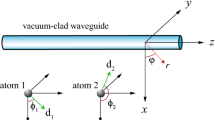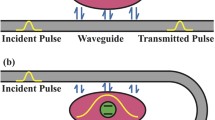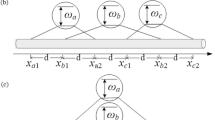Abstract
Waveguide electrodynamics has been attracted much attention; however, a waveguide with a cross section has seldom considered. We study two two-level systems (TLSs) interacting with a reservoir of guided modes confined in a rectangular waveguide of a cross section. For the energy separation of the identical TLSs far away from the cutoff frequencies of transverse modes, the delay differential equations are obtained with single-excitation initial in the TLSs. We accurately solved the delay differential equations for the TLSs interacting with either single transverse mode or double transverse modes of the waveguide. The retarded character of multiple reemissions and reabsorptions of photons between the TLSs is revealed, and the effects of the inter-TLS distance on the time evolution of the concurrence of the TLSs is examined.





Similar content being viewed by others
Explore related subjects
Discover the latest articles, news and stories from top researchers in related subjects.References
Dodd, P.J., Halliwell, J.J.: Disentanglement and decoherence by open system dynamics. Phys. Rev. A 69, 052105 (2004)
Yu, T., Eberly, J.H.: Quantum open system theory: bipartite aspects. Phys. Rev. Lett. 93, 140404 (2004)
Yu, T., Eberly, J.H.: Quantum open system theory: bipartite aspects. Phys. Rev. Lett. 97, 140403 (2006)
Dicke, R.H.: Coherence in spontaneous radiation processes. Phys. Rev. 93, 99 (1954)
Lehmberg, R.H.: Radiation from an N-atom system. I. General formalism. Phys. Rev. A 2, 883 (1970)
Feng, X.-P., Ujihara, K.: Quantum theory of spontaneous emission in a one-dimensional optical cavity with two-side output coupling. Phys. Rev. A 41, 2668 (1990)
Ordonez, G., Kim, S.: Complex collective states in a one-dimensional two-atom system. Phys. Rev. A 70, 032702 (2004)
Berman, P.R.: Spontaneous emission and scattering in a two-atom system: conservation of probability and energy. Phys. Rev. A 76, 043816 (2007)
Ficek, Z., Tanaś, R.: textit Dark periods and revivals of entanglement in a two-qubit system. Phys. Rev. A 74, 024304 (2006)
Ficek, Z., Tanaś, R.: Delayed sudden birth of entanglement. Phys. Rev. A 77, 054301 (2008)
Kielpinski, D., Volin, C., Streed, E.W., Lenzini, F., Lobino, M.: Integrated optics architecture for trapped-ion quantum information processing. Quantum Inf. Process. 15(12), 5315–5338 (2016)
He, Q.L., Xu, J.B., Yao, D.X.: Mediating and inducing quantum correlation between two separated qubits by one-dimensional plasmonic waveguide. Quantum Inf. Process. 12(9), 3023–3031 (2013)
Peng, Z.H., Jia, C.X., Zhang, Y.Q., Zhu, Z.H., Tang, S.Q., Yuan, J.B., Liu, X.J., Kuang, L.M.: Hybrid Toffoli gates with dipole-induced transparency effect in series and parallel cavity-waveguide systems. Quantum Inf. Process. 18(9), 284 (2019)
Tien, P.K.: Integrated optics and new wave phenomena in optical waveguides. Rev. Mod. Phys. 49, 361 (1977)
Hammerer, K., Søensen, A.S., Polzik, E.S.: Quantum interface between light and atomic ensembles. Rev. Mod. Phys. 82, 1041 (2010)
Caruso, F., Giovannetti, V., Lupo, C., Mancini, S.: Quantum channels and memory effects. Rev. Mod. Phys. 86, 1203 (2014)
Kong, J.A.: Electromagnetic Wave Theory. Wiley, New York (1986)
Shen, J.T., Fan, S.: Coherent single photon transport in a one-dimensional waveguide coupled with superconducting quantum bits. Phys. Rev. Lett. 95, 213001 (2005)
Shen, J.T., Fan, S.: Coherent photon transport from spontaneous emission in one-dimensional waveguides. Opt. Lett. 30, 2001 (2005)
Shen, J.T., Fan, S.: Strongly correlated two-photon transport in a one-dimensional waveguide coupled to a two-level system. Phys. Rev. Lett. 98, 153003 (2007)
Zhou, L., Gong, Z.R., Liu, Y.-X., Sun, C.P., Nori, F.: Controllable scattering of a single photon inside a one-dimensional resonator waveguide. Phys. Rev. Lett. 101, 100501 (2008)
Zhou, L., Yang, L.-P., Li, Y., Sun, C.P.: Quantum routing of single photons with a cyclic three-level system. Phys. Rev. Lett. 111, 103604 (2013)
Lu, J., Zhou, L., Kuang, L.-M., Nori, F.: Single-photon router: coherent control of multichannel scattering for single photons with quantum interferences. Phys. Rev. A 89, 013805 (2014)
Lu, L., Zhou, L.: T-shaped single-photon router. Opt. Express 23, 22955 (2015)
Zheng, H.-X., Gauthier, D.J., Baranger, H.U.: Waveguide QED: many-body bound-state effects in coherent and Fock-state scattering from a two-level system. Phys. Rev. A 82, 063816 (2010)
Zheng, H.-X., Gauthier, D.J., Baranger, H.U.: Cavity-free photon blockade induced by many-body bound states. Phys. Rev. Lett. 107, 223601 (2011)
Zheng, H.-X., Gauthier, D.J., Baranger, H.U.: Strongly correlated photons generated by coupling a three- or four-level system to a waveguide. Phys. Rev. A 85, 043832 (2012)
Zheng, H.-X., Gauthier, D.J., Baranger, H.U.: Waveguide-QED-based photonic quantum computation. Phys. Rev. Lett. 111, 090502 (2013)
Tsoi, T.S., Law, C.K.: Quantum interference effects of a single photon interacting with an atomic chain inside a one-dimensional waveguide. Phys. Rev. A 78, 063832 (2008)
Shi, T., Sun, C.P.: Lehmann–Symanzik–Zimmermann reduction approach to multiphoton scattering in coupled-resonator arrays. Phys. Rev. B 79, 205111 (2009)
Shi, T., Fan, S., Sun, C.P.: Two-photon transport in a waveguide coupled to a cavity in a two-level system. Phys. Rev. A 84, 063803 (2011)
Shi, T., Fan, S.: Two-photon transport through a waveguide coupling to a whispering-gallery resonator containing an atom and photon-blockade effect. Phys. Rev. A 87, 063818 (2013)
Redchenko, E.S., Yudson, V.I.: Decay of metastable excited states of two qubits in a waveguide. Phys. Rev. A 90, 063829 (2014)
Ballestero, C.G., Vidal, F.J.G., Moreno, E.: Non-Markovian effects in waveguide-mediated entanglement. New J. Phys. 15, 073015 (2013)
Dai, J., Roulet, A., Le, H.N., Scarani, V.: Rectification of light in the quantum regime. Phys. Rev. A 92, 063848 (2015)
Huang, J.F., Shi, T., Sun, C.P., Nori, F.: Controlling single-photon transport in waveguides with finite cross section. Phys. Rev. A 88, 013836 (2013)
Shahmoon, E., Kurizki, G.: Nonradiative interaction and entanglement between distant atoms. Phys. Rev. A 87, 033831 (2013)
Li, Q., Zhou, L., Sun, C.P.: Waveguide quantum electrodynamics: controllable channel from quantum interference. Phys. Rev. A 89, 063810 (2014)
Song, H.-X., Sun, X.-Q., Lu, J., Zhou, Lan: Spatial dependent spontaneous emission of an atom in a semi-infinite waveguide of rectangular cross section. Commun. Theor. Phys. 69, 59 (2018)
Barnett, S.M., Radmore, P.M.: Methods in Theoretical Quantum Optics. Oxford University Press, Oxford (1997)
Milonni, P.W., Knight, P.L.: Retardation in the resonant interaction of two identical atoms. Phys. Rev. A 10, 1096 (1974)
Milonni, P.W., Knight, P.L.: Retarded interaction of two nonidentical atoms. Phys. Rev. A 11, 1090 (1975)
Cook, R.J., Milonni, P.W.: Quantum theory of an atom near partially reflecting walls. Phys. Rev. A 35, 5081 (1987)
Dung, H.T., Ujihara, K.: Thermal conductivity of single-walled carbon nanotubes. Phys. Rev. A 59, 2524 (1999)
Dorner, U., Zoller, P.: Laser-driven atoms in half-cavities. Phys. Rev. A 66, 023816 (2002)
Rist, S., Eschner, J., Hennrich, Markus, Morigi, G.: Photon-mediated interaction between two distant atoms. Phys. Rev. A 78, 013808 (2008)
Gulfam, Q.-A., Ficek, Z., Evers, J.: Effect of retardation on the dynamics of entanglement between atoms. Phys. Rev. A 86, 022325 (2012)
Lu, J., Zhou, L., Fu, H.C.: Dark-state mechanism for the long-time transfer of excitations in a donor-acceptor system. Phys. Lett. A 377, 1255 (2012)
Guimond, P.-O., Roulet, A., Le, H.N., Scarani, V.: Rabi oscillation in a quantum cavity: Markovian and non-Markovian dynamics. Phys. Rev. A 93, 023808 (2016)
Wootters, William K.: Entanglement of formation of an arbitrary state of two qubits. Phys. Rev. Lett. 80, 2245 (1998)
Kuhr, S., et al.: Ultrahigh finesse Fabry-Pérot superconducting resonator. Appl. Phys. Lett. 90, 164101 (2007)
Raimond, J.M., Brune, M., Haroche, S.: Colloquium: manipulating quantum entanglement with atoms and photons in a cavity. Rev. Mod. Phys. 73, 565 (2001)
Shahmoon, E., Kurizki, G.: Nonradiative interaction and entanglement between distant atoms. Phys. Rev. A 87, 033831 (2013)
Cook, R.J., Milonni, P.W.: Quantum theory of an atom near partially reflection walls. Phys. Rev. A 35, 5081 (1987)
Roy, D., Wilson, C.M., Firstenberg, O.: Colloquium: strongly interacting photons in one-dimensional continuum. Rev. Mod. Phys. 89, 021001 (2017)
Acknowledgements
This work was supported by NSFC Grants Nos. 11434011, 11575058.
Author information
Authors and Affiliations
Corresponding author
Additional information
Publisher's Note
Springer Nature remains neutral with regard to jurisdictional claims in published maps and institutional affiliations.
Appendix
Appendix
The detailed derivation of Eqs. (8) and (12).
We consider a system of two two-level atoms weakly coupled to a rectangular hollow metallic waveguide made of perfect conductors. Under the dipolar and rotating wave approximation, the total Hamiltonian in the Schrö dinger picture is
Any state of the two TLSs is linear superposition of the basis of the separable product states \(\left| 1\right\rangle =\left| g_{1}g_{2}\right\rangle , \left| 2\right\rangle =\left| e_{1}g_{2}\right\rangle , \left| 3\right\rangle =\left| g_{1}e_{2}\right\rangle \) and \(\left| 4\right\rangle =\left| e_{1}e_{2}\right\rangle .\) While in a single-excitation subspace, the basis \( \left\{ \left| 20\right\rangle , \left| 30\right\rangle , {\hat{a}} _{jk}^{\dagger }\left| 10\right\rangle \right\} \) is complete to describe the system because the number of quanta is conserved. Here, \(\left| 0\right\rangle \) is the vacuum state of the quantum field. So the wave function of the total system can be written as
\(b_{1}(t), b_{2}(t)\) and \(b_{jk}(t)\) are corresponding amplitude. The wave function of the total system obeys the Schrödinger equation
substituting Eqs. (24) and (25) into Eq. (26), we obtain
taking the overlap of the both sides of Eq. (27) with \(\left\langle 20\right| , \left\langle 30\right| \) and \(\left\langle 10\right| {\hat{a}} _{jk}\), respectively, gives
As the coupling strength is quite weak compared to the atomic frequency \(\omega _{A}\) and field frequencies \(\omega _{jk}\), we introduce three new variables to remove the high-frequency effect,
where \(z_{0}=z_{2}-z_{1}\). Integrating equation of \(B_{jk}(t)\) and inserting it into the equations for \( B_{1}(t)\) and \(B_{2}(t),\) we have
Then, take the linear expansion of dispersion relationship
into Eq. (31) and we assume the coefficient \(\frac{ g_{j}^{2}}{\omega _{jk}}\) is independent with frequencies, \(\frac{ g_{j}^{2}}{\omega _{jk}}\rightarrow \frac{ g_{j}^{2}}{\omega _{A}}\), which is a variant of Weisskopf–Wigner theory [54], Eq. (31) can be expressed as
where \(\mu ,\nu =1,2(\mu \ne \nu )\), \(\gamma _{j}=\frac{\pi g_{j}^{2}}{v_{j}\omega _{A}}\). The integral bound are approximated as \(\int _{ 0}^{+\infty }\mathrm{d}k\simeq \frac{1}{2}\int _{-\infty }^{+\infty }\mathrm{d}k\), since we are only interested in photons with a narrow bandwidth in the vicinity of \(\omega _{A}\) [55]. Then, from Eq. (33) we know that for \(\mu =1,\nu =2\)
and for \(\mu =2,\nu =1\)
where \(d=|z_{0}|\), \(\varTheta (x)\) is the Heaviside unit step function and the formula \(\int _{0}^{t}f(\tau )\delta (t-\tau )\mathrm{d}\tau =\frac{1}{2}f(t) \) is applied.
Rights and permissions
About this article
Cite this article
Hu, L., Lu, G., Lu, J. et al. Concurrence of two identical atoms in a rectangular waveguide: linear approximation with single excitation. Quantum Inf Process 19, 81 (2020). https://doi.org/10.1007/s11128-020-2577-y
Received:
Accepted:
Published:
DOI: https://doi.org/10.1007/s11128-020-2577-y




